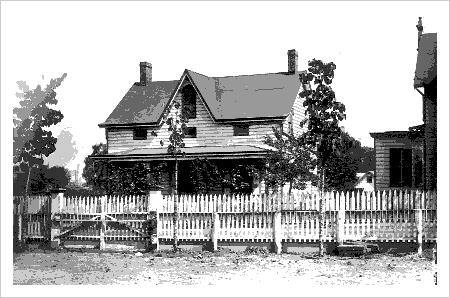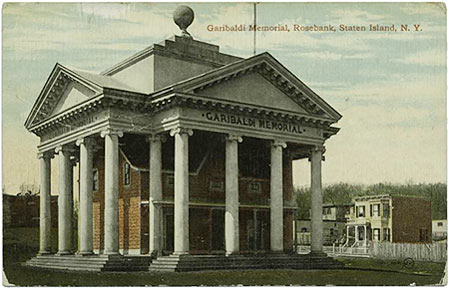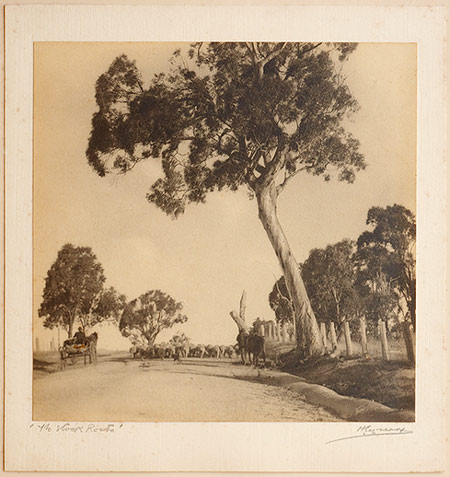Marking time in December 2005
Garibaldi’s Pantheon
This is a reminder to myself, to discover more about the New York cottage in which the Italian patriot Giuseppe Garibaldi lived between 1850 and 1854. It was the house of Antonio Meucci, belatedly acknowledged as the inventor of the telephone.

When Garibaldi died in 1884 a committee was formed to commemorate the hero’s stay on these shores. Meucci was on hand that year when a marble plaque was placed over the front door of the house. After Meucci’s death, the house was turned over to the Italian community to be preserved as a memorial to Garibaldi.
By 1907, on the centennial of the hero’s birth, the house was moved to it’s present location, where a pantheon was erected over it. In 1919, the Garibaldi Society turned over the house to the Order Sons of Italy in America. The Order has restored and maintained the house ever since. With the assistance of the cultural department of the Italian Embassy, artifacts were collected from around the world. In May of 1956 the house was opened to the public and rededicated as the Garibaldi-Meucci Museum. Today the museum is a National Landmark owned and operated by the Order Sons of Italy in America. Come visit us and imagine Garibaldi and Meucci actually talking over the first telephone in 1850 in a quaint home on Staten Island. [Blurb from the Garibaldi-Meucci Museum website]

The museum website does not explain when or why the remarkable Pantheon was removed. I found some clues in an on-line exhibit of photographs by Berenice Abbott: It appears that in 1952 the structure was decrepit and was torn down.
I am keen to know more about the pantheon’s design, construction and removal.
The Stock Route
As a small contribution to Alan Griffiths’ work of building a comprehensive website about photography, here is a photograph from my collection.

Harold Cazneaux, known affectionately as “Caz”, was a good-looking, modest little man, with a very big record, who became the benevolent father of Pictorialism in Australia. [Jack Cato, The story of the camera in Australia (1955), p. 150.]
His choice of subjects, his splendid instinct for design and light and shade, certainly puts him as an artist above many of our painters. No one has represented trees in any way comparable with those in his prints. He is a landscape man of the first water. He has a great gift. [Sir Arthur Streeton, 1950, quoted by Cato, p. 154]
The gentle romanticism of the pictorialists was divorced from the modern world. Images of work, for instance, were generally restricted to rural labourers and draughthorses. The pictorialist philosophy held that treatment was more important than subject matter, thus nearly any subject would be grist for the mill. Harold Cazneaux, the leading pictorialist, could make a fine picturesque study out of the demolition of a building, washing hanging in a dilapidated alley or a group of wharfies on a foggy morning. [Anne-Marie Willis, Picturing Australia: a history of photography (1988), p. 136]
Australian gum trees were another favoured motif and one with which Cazneaux is readily identified. The trees are invariably presented as strong, enduring forces, able to withstand the onslaught of time. [Helen Innes, Harold Cazneaux: the quiet observer (1994), p. 9]
Place all your effort, not in mere technique, but more so in the perfection of the art of selection and creative ideas in subject matter. Remember, too, that imagination also is necessary to focus those pictures in your mind … Let out the reins in your art studies but hold them tightly on technique, for today the latter has the nasty habit of getting out in front.[Harold Cazneaux, 1952, quoted by Helen Innes, p. 9]
There is a more tightly cropped print from this negative in the National Library, entitled Australian stock route.
Donald Knuth
Some idle reading about ways to break a paragraph into lines took me to an article in Wikipedia about TeX, the typesetting program created by Donald Knuth. A consumate ratbag, as I surmise from the article:
Knuth began to write TeX because he had become annoyed at the declining quality of the typesetting in volumes I–III of his monumental The Art of Computer Programming. In a manifestation of the typical hackish urge to solve the problem at hand once and for all, he began to design his own typesetting language. He planned he would finish it on his sabbatical in 1978, but as it happened the language was frozen only in 1989, more than ten years later.
TeX is unlike commercial software, which endlessly spawns new layers of complexity and flab:
Since version 3, TeX has used an idiosyncratic version numbering system, where updates have been indicated by adding an extra digit at the end of the decimal, so that the version number asymptotically approaches π. This is a reflection of the fact that TeX is now very stable, and only minor updates are anticipated. … The current version of TeX is 3.141592; it was last updated in December 2002.
Knuth has shown a remarkable committment to improving the quality of the program:
Knuth offers monetary awards to people who find and report a bug in it. The award per bug started at $2.56 and doubled every year until it was frozen at its current value of $327.68. This has not made Knuth poor, however, as there have been very few bugs claimed and in any case a cheque proving that the owner found a bug in TeX is usually framed instead of cashed.